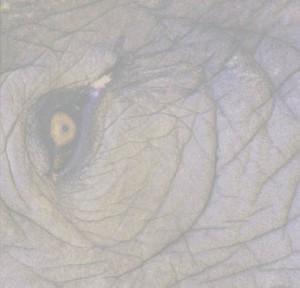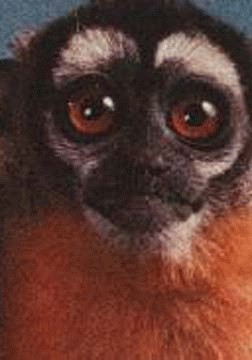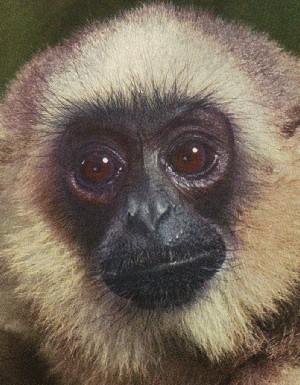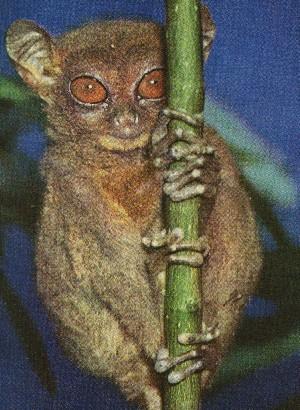lined link to go to subject)
Chapter 1. Vision
System Design
Chapter 2. Biological Eye Designs
Chapter
3. Eye
Design
Illustrations
A.
Plant
light sensing
1.
Grass, simple vines,
and stems
2.
Flowers
B.
Lower
animal eyes
1.
Flatworms
2.
Clams and Scallops
3.
Nautilus
4.
Shrimp
5.
Crab
6.
Octopus and
giant squid
7.
Spiders
8.
Scorpions
8.
Brittle Star
C.
Insect
eyes
1.
Bees
2. Dragonflies
3. Butterflies
4.
Flies
5.
Ants
6.
Moths
7.
Beetles
8.
Wasp
D. Fish
eyes
1.
Shark
2.
Flounder
3.
Four-eyed fish
E.
Amphibian
eyes
1. Frog
2.
Salamander
F.
Reptile
eyes
1. Boa
constrictor
2.
Rattle
snake
3.
Lizard
4.
Turtle
5.
Crocodile
and
alligators
G. Bird
eyes
1.
Eagles
2.
Hummingbirds
3. Owls
4.
Ostrich
5.
Cormorants
H.
Mammal
eyes
1.
Whales
2.
Elephants
3. Lions,
tigers, and
other cats
4.
Monkeys
5. Rats
and mice
6. Bats
7.
Tarsier
I.
Human
eyes
1. Iris
2. Lens
3.
Retina
Chapter
4. Eye
Reproduction
Chapter
5. Optical
Systems
Design
Chapter
6. The Eye Designer
Related
Links
Appendix
A - Slide Show & Conference Speech by Curt Deckert
Appendix
B - Conference Speech by Curt Deckert
Appendix
C - Comments From Our Readers
Appendix
D - Panicked Evolutionists: The Stephen Meyer Controversy
Chapter 3
Section H
(Click on PICTURE IN TEXT to bring up LARGE PICTURE)
3. EYE DESIGN ILLUSTRATIONS
H.
Mammal eyes
Mammals have
camera-type eyes with a refractive lens to give well-corrected
medium-to-high-resolution vision. Most mammals, including humans (see
following section), have good focusing capability. This makes their
eyes more versatile than more primitive eyes that are limited to fixed
focus. High levels of preliminary parallel image processing are used
with these eyes before signals go to the brain. Since most mammal
brains are proportionally larger than those of most other creatures,
they have the resources to process more information for recognition and
protection. Eye optics transform light waves into visual images on the
retina that provides much of the information received by the human
brain. Since the eye is of extreme importance in the mammal
functioning, since a large portion of the brain is used for visual
processing. The relative size of eyes varies with families, size, and
needs of the various mammals. The number of eyes, basic design, and
construction of eyes is also quite consistent within most mammal
species.
Mammal eyes are almost spherical in shape and are located in orbital
sockets in the skull. Eyelids covering the eyeballs appear to modify
the shape. In general, sight occurs as light waves enter the eye
through the cornea (the transparent layer at the front of the eye),
pass through the pupil (the opening in the center of the iris, the
colored portion of the eye), and then through a clear lens
located behind the iris. This lens focuses a light image onto
the retina, which functions like the film in a film-camera or a CCD
sensor in an electronic camera. Photoreceptor neurons in retinas,
called rods and cones, then convert light energy into chemical and
electrical impulses, which are carried to the brain via the optic
nerves. At the visual cortex in the brain, electrical impulses are
visualized as images. (Fig 3.44a adapted from 1999 Eye Poster from
Anatomical Chart Co. Skokie, IL) (Fig 3.44b from p. 135, Iridology,
Vol. 2, 1982, published by Bernard Jensen Enterprises, Escondido, CA
92027)
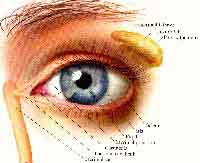
Human Eye. |
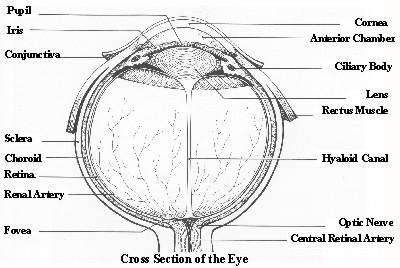
Eye as Typical Mammal Eye |
Hunting mammals have eyes forward, while hunted mammals have eyes on the side of their heads. The hunted animals need a wider field of view to see the hunters.
Some mammal eyes contain the equivalent of a curved mirror at the retina surface at the back of the eye where the eye reflects light back through sensors to its source. Mammals that have this type of eye include cats, whales, dolphins, horses, rabbits, antelopes, and hippos, etc. The color reflected is the primary color of the visual pigments in the photoreceptors. For example, white light reflects golden from cats' eyes, red from rabbits and hippos, and white from antelope.
Since mammals' eyes appear to be designed for unique roles, their eyes' controls and interfaces are uniquely programmed to process information for each vision system requirement. The following are some examples of mammal vision systems that illustrate the variation of mammal eyes.
1. Whales
Whale eyes are about the size of a grapefruit. Because these multi-ton mammals can swim deep, their eyes need to be protected from high pressure just as eyes of sharks and other similar fish are protected by hydraulic compensation. Whales are able to see well, both above and below the water using hydraulics to provide different focus positions in the eye. They can also see long distances in a variety of situations. They seem to navigate using solar or star patterns, when they are not able to see land. They have significant intelligence, as evidenced by how well they can be taught specific behaviors. (Figure 3.45 adapted from p. 94, Vision in the Animal World, Rubin Smythe, Macmillan Press, 1975) (Figure 3.46a from P. 294, Readers Digest, Exploring the Secrets of Nature, 1994), (Fig 3.46b from the National Resources Defense Council 40 W. 20th Street, New York, NY 10011, The Photo is by Frank Balthis. It is a newborn gray whale "spy hopping" in the San Ignacio Lagoon- the last untouched whale nursery in North America. Even small whales have some of the largest eyes of any living creature.)
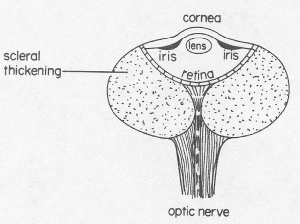
Whale Eyes. |
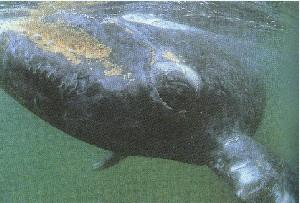
Whale Eyes |
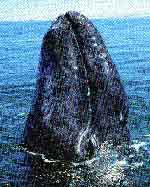
Whale Eye |
Like all cats, lions have retro-reflection characteristics that allow the eye to reflect light back to its source. Lions and tigers have large eyes, with long-distance vision, which they need for hunting. Like birds, such as hawks and eagles, they have good distance and night vision. Because of their excellent sight and tracking capabilities, they are among the best hunters in the world. Cat eye cross section is shown on fig 3.48. (Adapted from p77 Vision in the Animal World, R H Smythe, Macmillan Press, 1975)
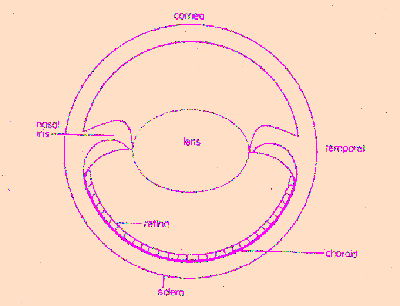
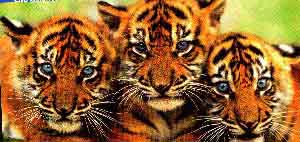
|
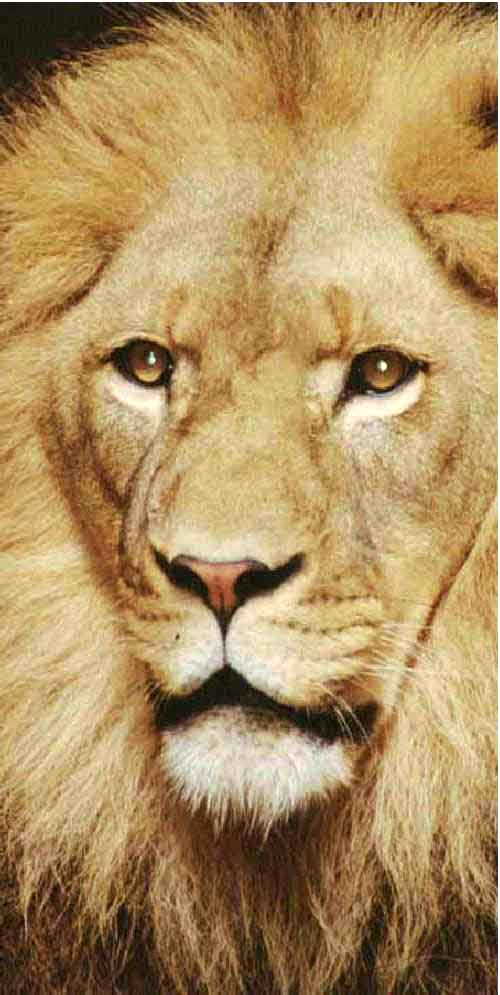
(By Bruce Chambers) |
5. Rats and mice
Rat eyes contain a
high index of refraction as its lens material. Their small camera-type
eye requires unique lens materials equivalent to high index of
refraction glasses. This allows a larger numerical aperture or smaller
f/number lens to collect more light from a small eye. The light
collecting capability of the rat's eye is quite efficient. This allows
their small eyes to see in the dark better than many other mammals.
Some mice eyes have been modified genetically to see better in the IR
and UV regions. For example, they can see at approximately
360nm (UV) light have a hard time seeing while humans below
400nm wavelength light. This comes from establishing UV cones in the
eye with the proper pigments. In general this kind of UV light is
harmful to human eyes, but since mice do not live long, their eye
tissue is less important. The rat's eye is a good example of a small
eye from which one can model small man-made optical systems.
(Pg. 57 The Illustrated
Encyclopedia of the Animal Kingdom,
1970, Danbury Press)
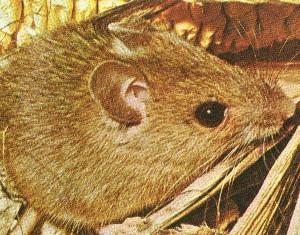
|
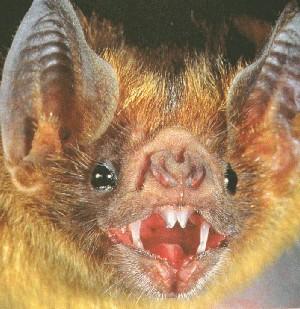
|
